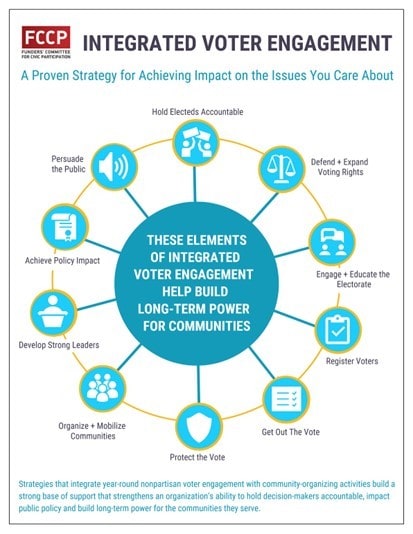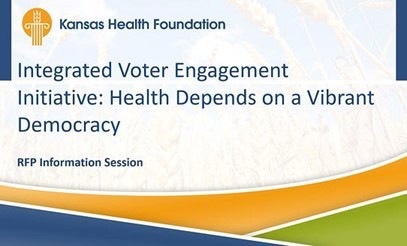Note: This is the first of a four-part series on “Integrated Voter Engagement” in Kansas. This article looks at the history of IVE and how it started in Kansas. Part 2 looks at the healthcare foundations funding IVE in Kansas. Part 3 shows the Kansas nonprofits receiving funding to engage in IVE. Part 4 reveals the impact of IVE on Kansas, and especially the “blueing” of Johnson County. The series is reprinted with author Earl F. Glynn’s permission. Glynn is a mostly retired Data Scientist, Scientific Programmer, Software Engineer, and Physical Scientist who lives in Olathe.
From 2017 to 2025, Wichita-based Kansas Health Foundation will spend over $5 million on two phases of Integrated Voter Engagement (IVE) to push for health equity in Kansas through the election process.
Combined with IVE spending by Kansas City area health foundations, Health Forward and REACH Healthcare Foundation, and related expenses but not formally part of the IVE program, total spending by health foundations will approach nearly $9 million to make Kansas healthier through voting. Does that make sense?
Let’s start with a bit of history of Integrated Voter Engagement.
In 2011, the progressive Funders’ Committee for Civic Participation (FCCP) published a document on their website, Integrated Voter Engagement: A Proven Model to Increase Civic Participation.
The document was written by Lee Winkelman “based on research and writing by Jeff Malachowsky,” who is a liberal philanthropist and former president of the left-of-center Voter Registration Project.
While published in 2011, the document’s filename suggests it was finalized in 2009, with examples from the previous decade.
The document gives this brief definition of Integrated Voter Engagement (IVE):
Research has shown that nonpartisan Integrated Voter Engagement (IVE) is among the most effective ways to increase voter turnout.
IVE groups train community members to reach out to their peers in a continuous, ongoing effort that increases the number of voters and leads to policy changes.
The most effective IVE organizations add new people to the voter registration rolls, educate voters about election issues, make sure new and unlikely voters actually cast their ballots, and ensure that misinformation and intimidation don’t inhibit people from voting.
In addition, their work has a long-term impact by developing local leaders and involving people in shaping the public policy decisions that affect their lives.
Do any groups on the right “reach out to their peers in a continuous, ongoing effort that increases the number of voters and leads to policy changes?”
With IVE, voting is more about the mechanics and logistics of voting and less about ideas and philosophy.
The result of only one side engaged in IVE is a tilted playing field for voting.

Malachowsky described five characteristics of IVE programs:
- Staff and leaders are drawn from the community.
- Election work is ongoing and integrated with issue work in a continuous cycle.
- IVE emphasizes leadership development.
- Enhanced voter lists focus voter work where it is most effective in reaching underrepresented communities.
- IVE not only increases voter participation but also leads to policy changes.
One of the three case studies in the document gave information about how IVE was instrumental in turning Colorado from a “red” state to a “blue” state through the Colorado Progressive Coalition, especially between 2002 and 2006.
The 2010 book The Blueprint: How the Democrats Won Colorado (and Why Republicans Everywhere Should Care) gives more details.
[The Blueprint Kansas organization is doing business as KSVotes.org and is telegraphing its goal in its name.]
The “next frontier” in 2014 for FCCP: Integrated Voter Engagement
In 2013, the FCCP published an IVE model that purportedly “strengthens organizational infrastructure and builds resources – in and out of election cycles – that can be mobilized to win effective public policies, making voter participation relevant and meaningful.”
Tate Hausman, who then was the managing director of the shadowy Analyst Institute headquartered a the address of the AFL/CIO in DC, talked about “Integrated Voter Engagement” as the “next frontier” at the first meeting of a new FCCP Research and Experimentation Working Group in July 2014.
From their web page: “Analyst Institute collaborates with progressive organizations and campaigns around the country to measure and increase the impact of their programs.” Some of their “best practices” have been leaked on the Internet, such as their get-out-the-vote checklist.
Hausman’s expertise was researching ways to make voting more effective for progressive causes. As the director of management at MoveOn.org, he ran experimental voter engagement programs that helped progressives rack up victories in 2012. Hausman had directed a number of national political operations to mobilize voters in Ohio to swing to Barack Obama in 2008.
NEO Philanthropy is the real name for FCCP
According to Capital Research in The Left’s Voting Machine, “the Funders Committee (FCCP) isn’t itself a genuine nonprofit, but a front for NEO Philanthropy, a 501(c)(3) passthrough funder and leading ‘dark money’ group that incubates new activist groups.”
 FCCP is an “affinity group for major donors and foundations to synchronize the flow of money to leftist political nonprofits.” The FCCP finances are buried in IRS 990s filed by NEO Philanthropy.
FCCP is an “affinity group for major donors and foundations to synchronize the flow of money to leftist political nonprofits.” The FCCP finances are buried in IRS 990s filed by NEO Philanthropy.
At the Oct. 2015 FCCP Fall Convening, Hausman addressed funders about IVE details.
Tate Hausman talked to progressive funders about Integrated Voter Engagement at the 2015 FCCCP Fall Convening in Washington, DC.
The FCCP had developed a model and plans for funders to embrace IVE.
FCCP’s Integrated Voter Engagement Model in Jan. 2017
While FCCP was refining its IVE model in 2016, the Kansas Health Foundation joined as a member. (The Arabella Advisors, who manage five “dark money” funds largely to impact elections, also joined FCCP in 2016.)
FCCP refined its 2013 IVE model and published this “spoke” model online in Jan. 2017.

In Jan. 2017 the Funders’ Committee for Civic Participation updated its Integrated Voter Engagement model with a few additional spokes.
Civic engagement became healthcare?
Over the last decade or so, the term “civic engagement” evolved to “civic health,” which then evolved to “social determinant of health,” and finally, “healthcare.”
Since voting is part of civic engagement, we now have the equation “voting = healthcare” in the minds of progressives.
You must vote to safeguard your health?
- There are no known ICD-10 medical diagnosis codes connecting healthcare problems to voting or civic engagement.
- There are no known CPT-4 procedure codes about medical services or procedures that would address problems with voting or elections.
- There are no known LOINC codes for laboratory tests and results related to voting or elections.
Yet healthcare foundations are now getting involved in the political process as part of healthcare.
Kansas Civic Health Index
In 2016, the Kansas Health Foundation published the “Kansas Civic Health Index,” which was not a peer-reviewed medical paper.
Kansas Civic Health Index provides a comprehensive, first-time look at civic and political engagement in Kansas. This report was developed in partnership between the Kansas Health Foundation and the National Conference on Citizenship (NCoC).
The report’s first recommendation was to increase participation in the democratic process:
Increase participation in the democratic process by focusing on:
- voter registration, education, and mobilization;
- government transparency;
- campaign finance reform; and
- leadership diversity.
A KHF press release from Oct. 2020 claimed:
With statistics taken from the KHF 2016 Kansas Civic Health Index, a connection can be made between civic engagement and health outcomes, as the same groups that demonstrate lower civic participation also have higher levels of tobacco use, obesity and most infectious diseases.
How does voting help with tobacco use, obesity, and infectious diseases?
But, healthcare is now politics?
What is known about the National Conference on Citizenship?
NCoC received funding from several progressive organizations, including:
- $334,000 in 2020 from George Soros’ Foundation to Promote Open Society.
- $200,000 in 2022 from Omidyar Network Fund (Ebay’s Pierre Omidyar).
- $102,630 in 2002 from Democracy Fund (Ebay’s Pierre Omidyar).
- $186,625 in 2021 from the Silicon Valley Community Foundation.
- $40,000 in 2019 from Rockefeller Brothers Fund.
- a “partnership” with Fair Count, founded by Stacey Abrams in Georgia.
The Kansas Health Foundation used its 2016 Kansas Civic Health Index as an excuse to start Integrated Voter Engagement in Kansas.
Kansas Health Foundation embraces FCCP’s IVE in Aug. 2017
About seven months after FCCP revealed their updated IVE model, the Kansas Health Foundation included it in a request for a proposal for IVE in Kansas.

View the PDF of the complete slide deck from the Aug. 11, 2017 Kansas Integrated Voter Engagement Information Meeting:
View the 41-minute video of the IVE informational meeting.
Integrated voter engagement is not the first political foray for Kansas Health Foundation.
Part 2 will look at the healthcare foundations involved in funding IVE in Kansas.



